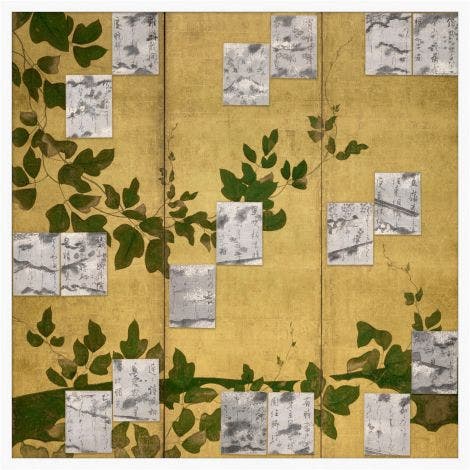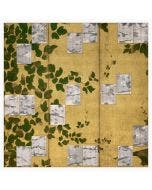Local Storage seems to be disabled in your browser.
For the best experience on our site, be sure to turn on Local Storage in your browser.
Anthology with Vines 2

This Met x Wendover Art Group design is a reproduction of an original work of art in The Metropolitan Museum of Art collection.
Anthology of Japanese and Chinese Poems with Underpainting of Arrowroot Vines
Calligraphy by Konoe Nobuhiro (Japanese, 1599–1649)
Underpainting attributed to Hasegawa Sōya (Japanese, born 1590),
Six-panel folding screen; ink and color on gilt paper; early 17th century,
Purchase, several members of The Chairman’s Council Gifts, 2001 2001.423
Swaying arrowroot vines (kuzu) in autumnal decline serve as the background for an array of Japanese and Chinese poems inscribed on poem cards (shikishi). The poems share common themes such as the four seasons, bamboo, pines, and clouds. The idiosyncratic style of the calligraphy, with hooks at the ends of strokes and the tall, elongated profile of the characters, is attributable to the nobleman-calligrapher Konoe Nobuhiro. In East Asia, the arts of poetry, calligraphy, and painting are considered the “three perfections,” and since the 9th century, the Japanese have decorated screens with paintings and poems inscribed in fine calligraphy.

This Met x Wendover Art Group design is a reproduction of an original work of art in The Metropolitan Museum of Art collection.
Anthology of Japanese and Chinese Poems with Underpainting of Arrowroot Vines
Calligraphy by Konoe Nobuhiro (Japanese, 1599–1649)
Underpainting attributed to Hasegawa Sōya (Japanese, born 1590),
Six-panel folding screen; ink and color on gilt paper; early 17th century,
Purchase, several members of The Chairman’s Council Gifts, 2001 2001.423
Swaying arrowroot vines (kuzu) in autumnal decline serve as the background for an array of Japanese and Chinese poems inscribed on poem cards (shikishi). The poems share common themes such as the four seasons, bamboo, pines, and clouds. The idiosyncratic style of the calligraphy, with hooks at the ends of strokes and the tall, elongated profile of the characters, is attributable to the nobleman-calligrapher Konoe Nobuhiro. In East Asia, the arts of poetry, calligraphy, and painting are considered the “three perfections,” and since the 9th century, the Japanese have decorated screens with paintings and poems inscribed in fine calligraphy.



